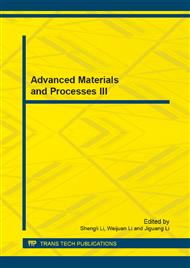p.84
p.88
p.96
p.100
p.104
p.116
p.121
p.125
p.133
Theoretical Studies on Structures and Properties of Pentazine,1,2,4,5-Tetrazine and s-Triazine Derivatives with Nitrogen - Containing Substitutents
Abstract:
B3LYP /aug-cc-pvdz level of theory, combined with NBO and G3 methods, is applied to study substituent effects on the geometries, bond dissociation energies and high energetic density material properties of 27 kinds of derivatives designed by substituted hydrogen atoms of pentazine, 1,2,4,5-tetrazine and s-triazine, of which the hydrogen atoms are substituted by CN, -NO2, -NH2, -N3, -N2H, -NHNH2, -N4H and-N4H3 groups. The relatively small heats of formation are observed for the derivatives substituted by-NH2, -H, -NO2 and-NHNH2. The order of heats of formation for the derivatives containing the same substituent is: pentazine > 1,2,4,5-tetrazine >s-triazine. For the derivatives substituted by-CN, -N2H and-N4H3, heats of formation are 860~1124 kJ/mol,in which heats of formation of 1,2,4,5-tetrazine derivatives are larger. For derivatives substituted by-N3 and-N4H, their heats of formation are 974 1735 kJ/mol, which are the highest in all derivatives. The order of heats of formation is: s-triazine derivative > 1,2,4,5-tetrazine derivative > pentazine derivative. The normalized heats of formation of these pentazine derivatives substituted by-CN-N3 ,- N2H and N4H and 1,2,4,5-tetrazine derivatives substituted by-CN-N3 and N4H are 93 109 kJ, which is higher than that of triazido-s-triazine and diazido-s-tetrazine derived from Hiskey. Our observations indicate that the higher heats of formation of substituent molecules have, the higher ones the substitutive derivatives. By means of the data of dissociation energy, it can be found that the heats of formation of derivatives substituted by N3, -N2H and CN are greater, and they are also more stable. It is possile for them to become energetic materials with high-energy and low sensitivity.
Info:
Periodical:
Pages:
104-115
Citation:
Online since:
September 2013
Authors:
Price:
Сopyright:
© 2013 Trans Tech Publications Ltd. All Rights Reserved
Share:
Citation:


